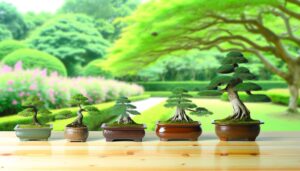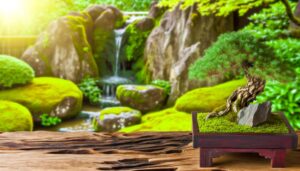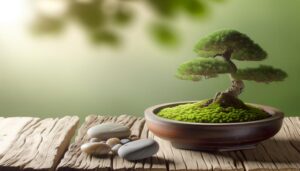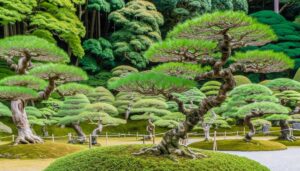What Different Types of Bonsai Pots Are There?
Selecting the right bonsai pot is crucial for optimizing root development, maintaining proper soil moisture, and enhancing overall aesthetics. Unglazed pots provide superior root aeration through their porous clay structure, while glazed pots offer vibrant colors and reduced soil moisture loss.
Ceramic pots combine durability with aesthetic versatility, and plastic pots are practical for their lightweight, cost-effective nature. Stoneware pots, known for their strength, are ideal for larger bonsai specimens.
Specialized types like cascade, oval, rectangular, and round pots cater to specific growth patterns and styles. Understanding these details guarantees your bonsai thrives in a suitable environment.
Discover more about tailored bonsai care and pot selections.
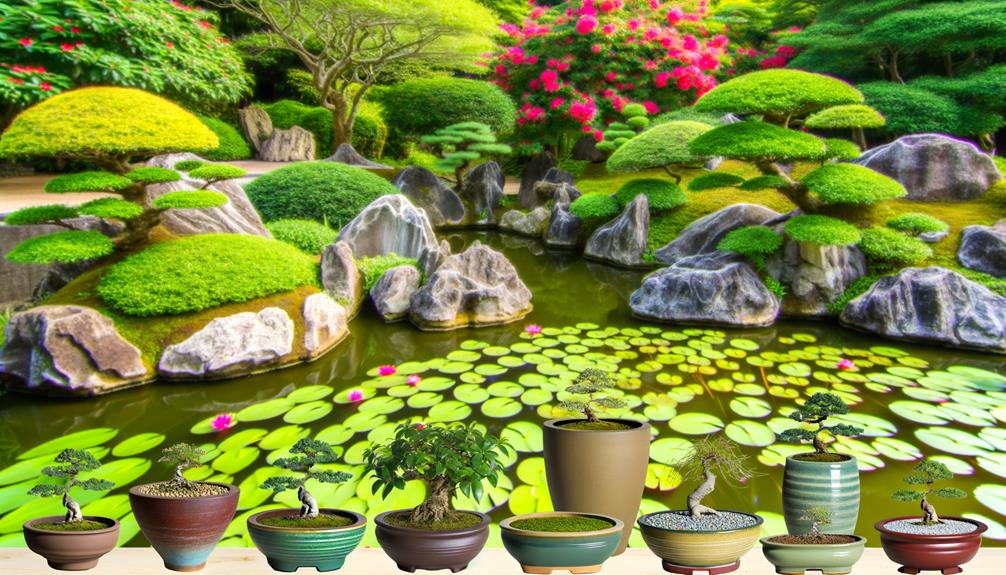
Key Takeaways
- Unglazed bonsai pots provide superior root aeration and thermal regulation with an earthy aesthetic.
- Glazed bonsai pots feature vibrant colors and reduced soil moisture loss for enhanced visual appeal.
- Ceramic bonsai pots offer durability, stability, and a wide range of colors and textures.
- Plastic bonsai pots are lightweight, cost-effective, and ideal for easy repotting and transportation.
- Stoneware bonsai pots are strong, durable, and suitable for larger bonsai specimens with an earthy texture.
Unglazed Bonsai Pots
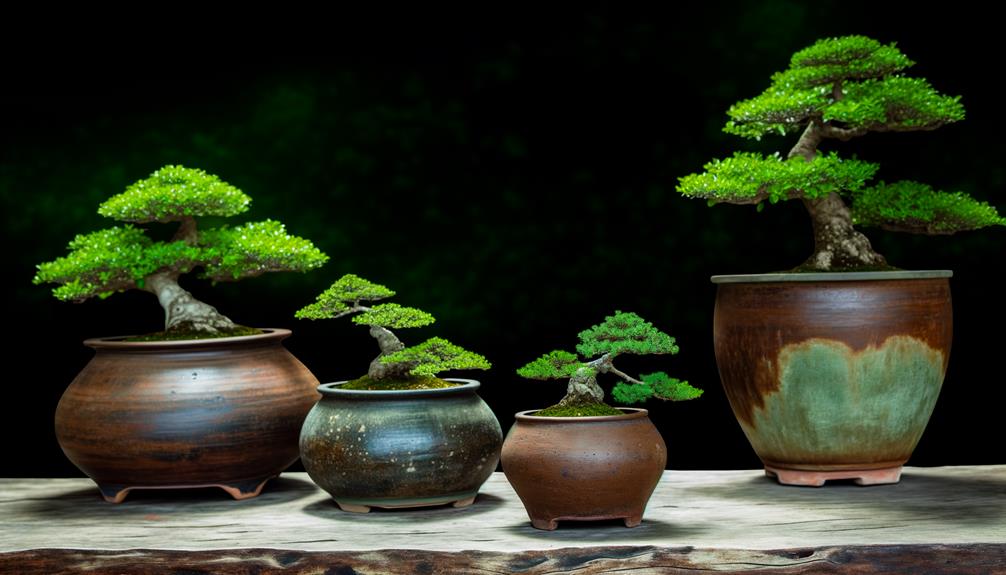
Unglazed bonsai pots, typically crafted from high-quality clay, are renowned for their porous nature, which facilitates ideal air and water exchange critical for the health of bonsai trees.
The unglazed surface allows for superior root aeration, promoting robust root development and preventing root rot. These pots are often preferred for conifers and deciduous species, as they offer a more natural aesthetic that complements the tree's organic form.
The clay material, often rich in minerals, provides micro-nutrients that benefit the bonsai over time. In addition, unglazed pots exhibit excellent thermal properties, helping to regulate soil temperature and moisture levels.
Their earthy tones and textures blend seamlessly with the natural environment, enhancing the visual harmony of the bonsai display.
Glazed Bonsai Pots
Glazed bonsai pots, characterized by their vibrant colors and glossy finishes, offer a striking contrast to the natural aesthetics of bonsai trees. These pots come in a variety of hues and textures, each meticulously crafted to complement specific tree species, such as flowering and fruit-bearing varieties.
The selection of a glazed pot is essential, as its visual impact and suitability must harmonize with the tree's overall appearance and horticultural requirements.
Colors and Textures
Offering a diverse palette of colors and surfaces, glazed bonsai pots enable the artist to complement the unique aesthetic of their bonsai trees while providing the functional benefit of a less porous container. These pots are available in a spectrum of hues ranging from earthy browns and greens to vibrant blues and reds, allowing for a harmonious or contrasting visual relationship with the tree.
The textures can vary widely, including smooth, glossy finishes and intricate, tactile designs. The glazing process not only enhances the visual appeal but also creates a vitreous layer that reduces water absorption, thereby improving the pot's durability. This combination of aesthetic versatility and functional resilience makes glazed pots a preferred choice for many bonsai enthusiasts.
Suitability for Tree Types
The aesthetic versatility and functional durability of glazed bonsai pots make them particularly suitable for specific tree species that thrive in environments with reduced soil moisture loss and enhanced root protection.
Glazed pots are ideal for species like Acer palmatum (Japanese Maple) and Ulmus parvifolia (Chinese Elm), which benefit from the moisture-retentive properties of the glaze. The non-porous finish of these pots minimizes evaporation, ensuring consistent hydration levels.
Additionally, the glazed surface provides a barrier against root overheating, vital for species sensitive to temperature fluctuations. This protective feature is especially beneficial for tropical bonsais such as Ficus and Serissa.
The interplay between the vivid glazes and the tree's foliage and bark enhances the visual appeal, creating a harmonious bonsai display.
Ceramic Bonsai Pots
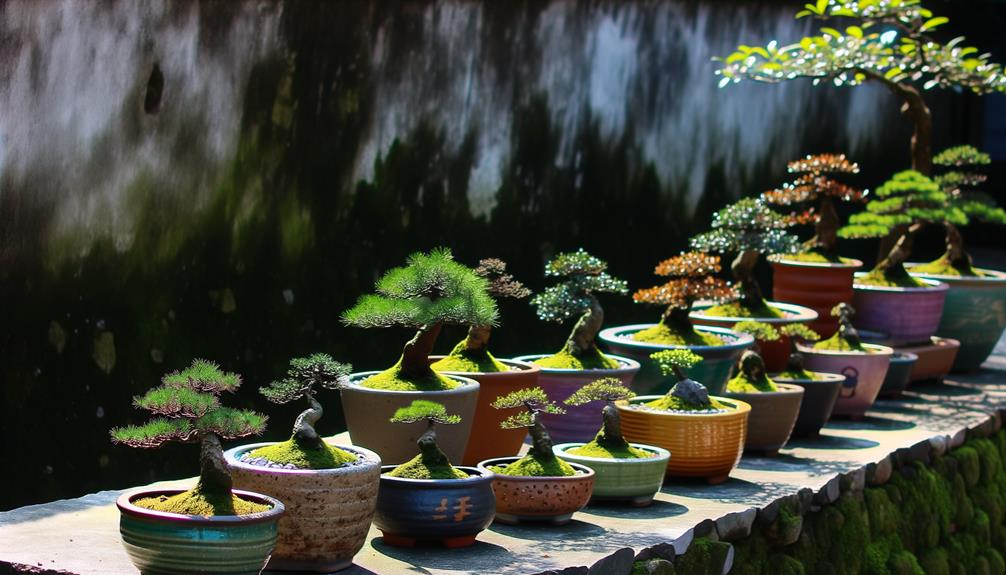
Ceramic bonsai pots, known for their durability and aesthetic appeal, are carefully crafted using high-temperature kiln firing to achieve both functional strength and intricate artistry.
These pots are often made of high-quality clays, which, when fired at temperatures exceeding 1200°C, result in a vitrified, non-porous surface. This process not only enhances their structural integrity but also ensures resistance to weathering and moisture.
The glaze, applied pre-firing, provides a wide range of color options and textures, creating a harmonious backdrop for the bonsai. Additionally, the weight of ceramic pots offers stability, essential for the development of the tree's root system.
Their various shapes and sizes cater to different bonsai species, making them a preferred choice among bonsai enthusiasts.
Plastic Bonsai Pots
While ceramic bonsai pots are praised for their durability and aesthetic appeal, plastic bonsai pots offer a lightweight and cost-effective alternative, suitable for both novice and experienced bonsai cultivators.
Providing superior flexibility in shapes and sizes, plastic pots are particularly advantageous for training young bonsai. Crafted from high-density polyethylene (HDPE) or polypropylene (PP), these pots demonstrate excellent resistance to UV radiation and temperature fluctuations, reducing the risk of root damage. Furthermore, their porous nature ensures ideal drainage and aeration, essential for healthy root development.
The lighter weight of plastic pots also simplifies the process of repotting and transportation. Despite their affordability, plastic bonsai pots can be designed to replicate the appearance of traditional materials, offering aesthetic versatility.
Stoneware Bonsai Pots
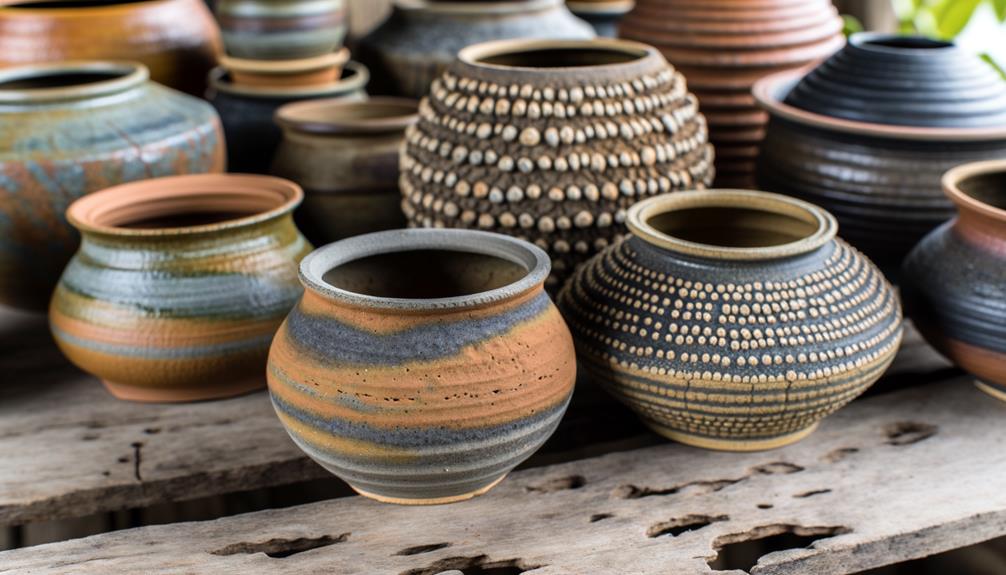
Stoneware bonsai pots, renowned for their exceptional strength and artisanal craftsmanship, provide an excellent balance of functionality and aesthetic elegance for bonsai enthusiasts.
These pots are fired at high temperatures, typically between 1200°C and 1300°C, resulting in a vitrified, non-porous structure that offers outstanding durability and resistance to the elements.
This high-fire process also imparts a distinctive, often earthy texture and color palette, enhancing the visual harmony between the pot and the bonsai.
Stoneware pots are available in various shapes and sizes, each meticulously designed to support ideal root health and moisture retention.
Their weight and stability make them particularly suitable for larger bonsai specimens, ensuring the tree remains securely anchored during growth and display.
Porcelain Bonsai Pots
Porcelain bonsai pots, characterized by their fine, delicate structure and high-shine finish, are typically fired at temperatures exceeding 1300°C, resulting in an exceptionally hard and nearly glass-like surface. These pots are highly valued in the bonsai community for their aesthetic appeal and durability. The high firing temperature produces a vitrified, non-porous body that is resistant to water absorption and staining.
Key features of porcelain bonsai pots include:
- Durability: The high firing temperature guarantees an exceptionally strong and resilient material.
- Aesthetic Appeal: Their high-shine finish and intricate designs enhance the visual presentation of bonsai trees.
- Non-porous Nature: Resistant to water absorption, preventing soil drying out too quickly.
- Variety: Available in numerous shapes, sizes, and colors to suit diverse bonsai species.
Wood Bonsai Pots
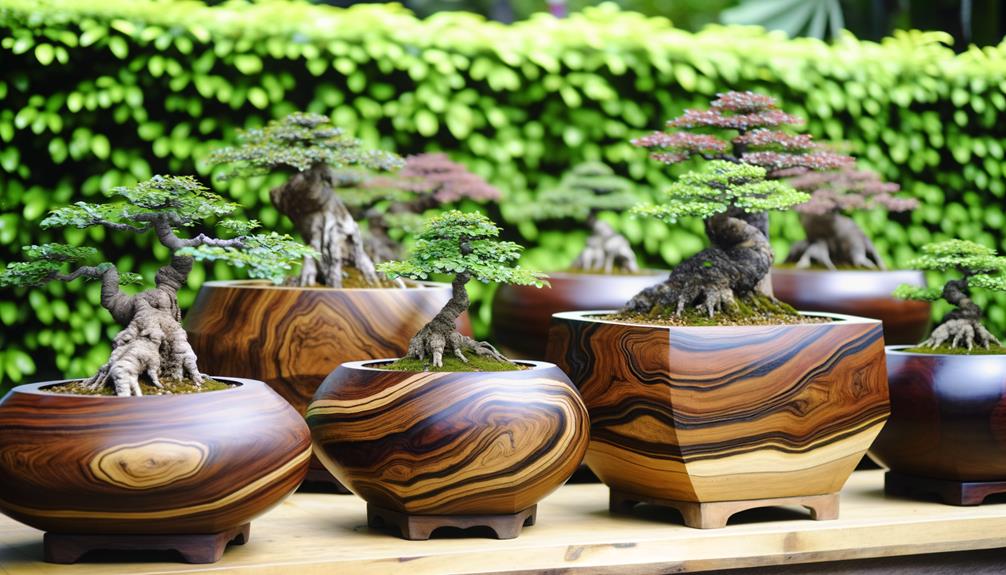
Wood bonsai pots offer a unique natural aesthetic appeal, harmonizing seamlessly with the organic elements of the bonsai tree.
While visually striking, these pots require diligent maintenance to guarantee longevity, as wood is susceptible to rot and insect damage.
Proper sealing and periodic treatment with protective coatings can enhance their durability, making them a viable option for bonsai enthusiasts who value both form and function.
Natural Aesthetic Appeal
Exuding a warm, organic charm, bonsai pots crafted from high-quality wood serve as a quintessential choice for enthusiasts seeking to enhance the natural aesthetic appeal of their miniature trees. The tactile texture and grain patterns of wooden pots seamlessly integrate with the bonsai, creating a harmonious visual experience.
When selecting a wood bonsai pot, consider the following elements:
- Wood Type: Cedar, teak, and oak offer distinct grain patterns and hues, enhancing the tree's visual appeal.
- Shape and Size: Choose a pot that complements the bonsai's proportions and style, ensuring balanced visual symmetry.
- Finish: Natural, stained, or varnished finishes can highlight the wood's beauty, adding depth to the display.
- Aging: Over time, wood develops a patina, enriching its aesthetic and adding character.
Understanding these factors elevates the bonsai's presentation, creating an exquisite, enduring display.
Durability and Maintenance
Ensuring the longevity of wooden bonsai pots involves understanding the specific maintenance requirements and inherent durability factors associated with different types of wood.
Hardwoods such as teak, oak, and cedar are preferred for their natural resistance to decay and moisture. Regular application of sealants or wood preservatives is critical to prolonging the pot's structural integrity.
In addition, proper drainage and ventilation must be maintained to prevent root rot and fungal issues. Seasonal inspections for signs of wear, such as cracks or warping, are essential.
Indoor storage during extreme weather conditions can mitigate the detrimental effects of temperature fluctuations. By adhering to these maintenance protocols, wooden bonsai pots can provide a durable and aesthetically pleasing environment for bonsai cultivation.
Cascade Bonsai Pots
Designed specifically to support the unique growth patterns of cascading bonsai, cascade bonsai pots are deeper than traditional pots to accommodate the downward growth of the tree's trunk and branches. These pots are essential for maintaining the aesthetic balance and structural integrity of cascade-style bonsai.
Key features include:
- Depth: Typically, these pots have a significant depth to allow for the extended root systems and lower trunk development.
- Drainage: Enhanced drainage systems ensure that excess water does not accumulate, which is important for the health of the bonsai.
- Shape: Often cylindrical or conical, these shapes support the unique growth trajectory of cascading bonsai.
- Material: High-quality ceramic or stoneware materials are preferred for their durability and ability to retain moisture effectively.
Understanding these elements is important for bonsai enthusiasts aiming to cultivate beautiful cascading bonsai.
Oval Bonsai Pots
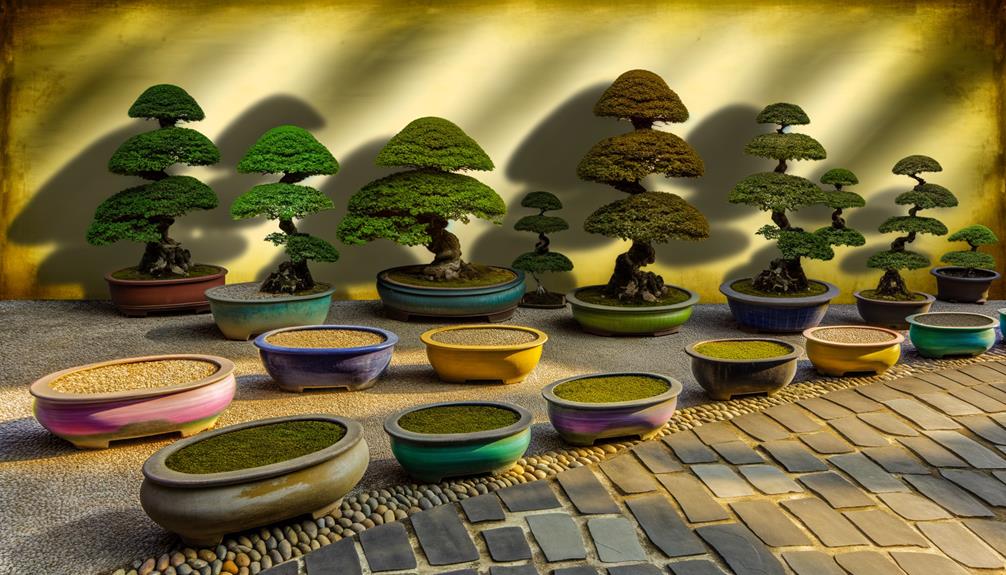
Oval bonsai pots are characterized by their gently curved, elongated shape, which provides a harmonious balance between aesthetic appeal and practical functionality for various bonsai styles. Their design is particularly suited for trees with a spreading root system, such as maple or elm species.
The curvature of the pot enhances the visual flow, complementing the natural contours of the bonsai. Oval pots often feature drainage holes and wiring points, essential for maintaining ideal soil aeration and securing the tree in place. The wider surface area allows for a more expansive display of the bonsai's nebari (root flare), emphasizing its age and stability.
Glazed and unglazed options offer versatility in complementing both the tree's foliage and the overall display aesthetics.
Rectangular Bonsai Pots
Rectangular bonsai pots, celebrated for their geometric precision, offer a structured framework that accentuates the formal and upright styles of bonsai trees. These pots are particularly favored for their ability to highlight the linear beauty and symmetry of tree species such as the Japanese Black Pine and Chinese Elm.
Key characteristics include:
- Stability: The elongated base provides enhanced stability, vital for top-heavy bonsai styles.
- Drainage: Multiple drainage holes are often incorporated to ensure ideal water flow and root health.
- Material: Typically made from high-fired ceramic, guaranteeing durability and resistance to weather extremes.
- Aesthetics: Their clean lines and sharp angles complement minimalist and modern bonsai displays, enhancing visual harmony.
Choosing the right rectangular pot can profoundly influence the overall presentation and health of your bonsai.
Round Bonsai Pots
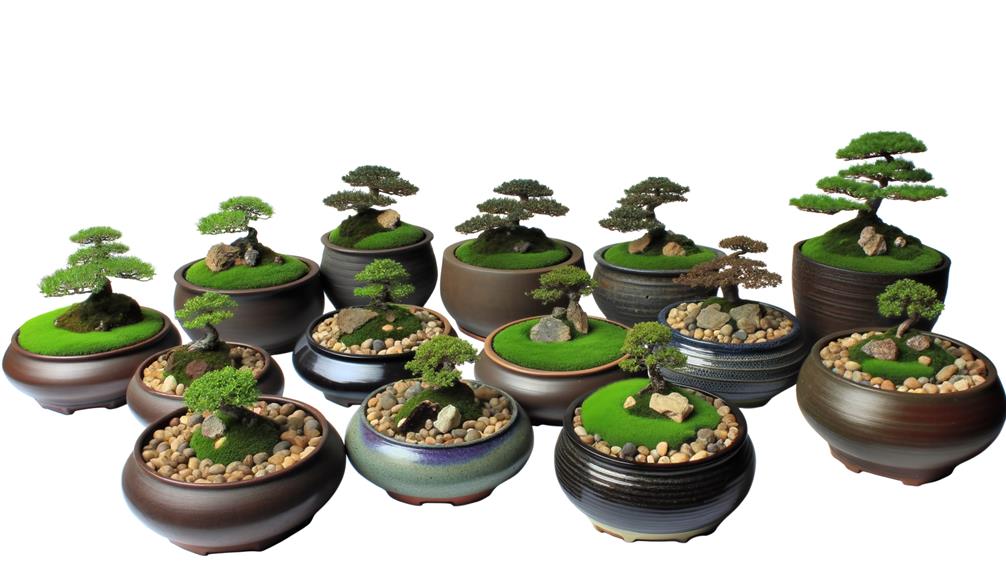
Round bonsai pots, revered for their harmonious and organic shape, offer a versatile and aesthetically pleasing option that complements various bonsai styles, particularly informal and cascading forms. These pots, typically crafted from high-fired ceramics, ensure durability and proper water retention.
The curvature of round pots enhances the visual flow, promoting a sense of continuous movement, making them ideal for species such as Junipers and Maples. Additionally, the round form provides a balanced root spread, optimizing nutrient absorption. The depth and diameter of these pots are crucial; they must align with the bonsai's root structure to prevent over-constriction or excessive growth.
Their neutral, often earthy glazes, allow the tree's foliage and trunk to remain the focal point.
Conclusion
In summation, the complex world of bonsai containers encompasses a diverse array of materials and forms, each carefully crafted to complement the aesthetic and horticultural needs of the bonsai specimen.
From the understated elegance of unglazed and stoneware pots to the vibrant allure of glazed ceramics, from the utilitarian plastic varieties to the specialized cascade forms, and the geometric versatility of oval, rectangular, and round designs, the selection of an appropriate vessel is crucial in the art of bonsai cultivation, ensuring both visual harmony and botanical health.

